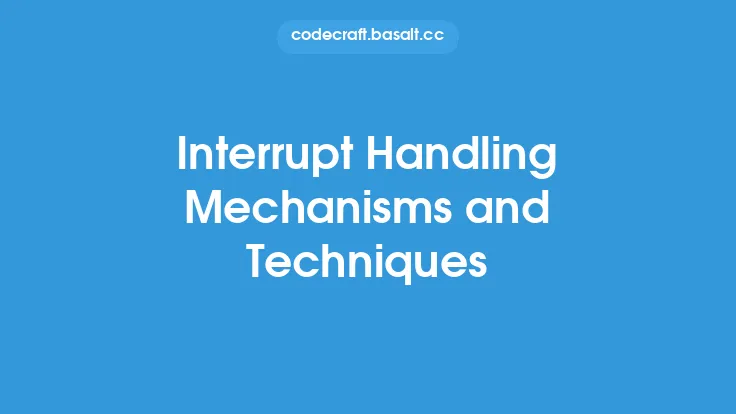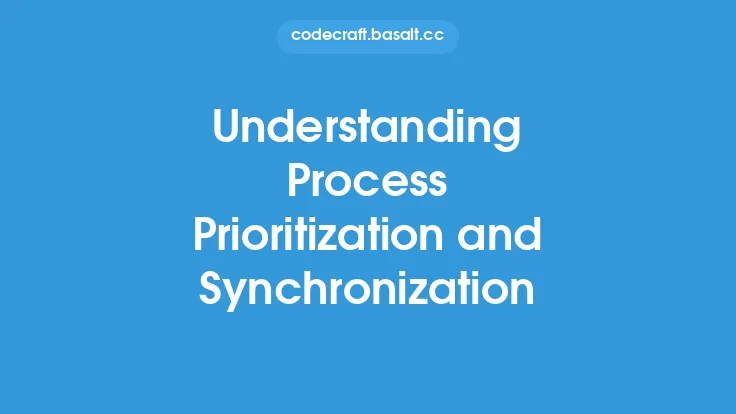Interrupt prioritization and resolution techniques are crucial components of operating system design, as they enable the efficient handling of interrupts and exceptions. Interrupts are signals to the CPU that an event has occurred and requires immediate attention, while exceptions are special types of interrupts that occur due to software or hardware errors. The prioritization and resolution of interrupts and exceptions are essential to ensure that the system responds promptly and correctly to these events.
Introduction to Interrupt Prioritization
Interrupt prioritization refers to the process of assigning a priority level to each interrupt, allowing the system to determine which interrupt to handle first when multiple interrupts occur simultaneously. This is typically done using a priority encoder, which assigns a unique priority level to each interrupt based on its urgency and importance. The priority levels are usually assigned based on the type of interrupt, with higher-priority interrupts being handled before lower-priority ones. For example, an interrupt generated by a disk completion might have a higher priority than an interrupt generated by a keyboard press.
Interrupt Resolution Techniques
Interrupt resolution techniques refer to the methods used to resolve conflicts that arise when multiple interrupts occur simultaneously. There are several techniques used to resolve interrupt conflicts, including:
- Priority-based resolution: In this technique, the interrupt with the highest priority is handled first. If multiple interrupts have the same priority, the system may use a round-robin scheduling algorithm to handle them in a cyclical manner.
- Vector-based resolution: In this technique, each interrupt is assigned a unique vector, which is used to determine the interrupt handler to be executed. The vector is typically stored in a table, and the system uses the interrupt number to index into the table and retrieve the corresponding vector.
- Maskable interrupts: In this technique, certain interrupts can be masked, or disabled, to prevent them from being handled. This is useful in situations where a high-priority interrupt needs to be handled without being interrupted by lower-priority interrupts.
Nested Interrupts
Nested interrupts refer to the situation where an interrupt handler is itself interrupted by another interrupt. This can lead to complex situations, as the system must be able to handle the nested interrupt while still processing the original interrupt. There are several techniques used to handle nested interrupts, including:
- Interrupt nesting: In this technique, the system allows interrupts to be nested, with each interrupt handler being able to handle additional interrupts. This requires careful management of the interrupt stack and the use of techniques such as interrupt masking to prevent infinite recursion.
- Interrupt disabling: In this technique, the system disables interrupts while handling an interrupt, preventing nested interrupts from occurring. This can lead to increased interrupt latency, as the system may need to wait for the interrupt handler to complete before handling additional interrupts.
Interrupt Prioritization Algorithms
Several algorithms are used to prioritize interrupts, including:
- Rate monotonic scheduling (RMS): This algorithm assigns priorities to interrupts based on their period and deadline. Interrupts with shorter periods and deadlines are assigned higher priorities.
- Earliest deadline first (EDF) scheduling: This algorithm assigns priorities to interrupts based on their deadline. Interrupts with earlier deadlines are assigned higher priorities.
- Fixed priority scheduling: This algorithm assigns a fixed priority to each interrupt, based on its type and importance.
Conclusion
Interrupt prioritization and resolution techniques are essential components of operating system design, enabling the efficient handling of interrupts and exceptions. By understanding the various techniques used to prioritize and resolve interrupts, system designers can create more efficient and reliable systems. The choice of interrupt prioritization algorithm and resolution technique depends on the specific requirements of the system, including the type of interrupts, the priority levels, and the desired level of responsiveness. By carefully considering these factors, system designers can create systems that respond promptly and correctly to interrupts and exceptions, ensuring reliable and efficient operation.





